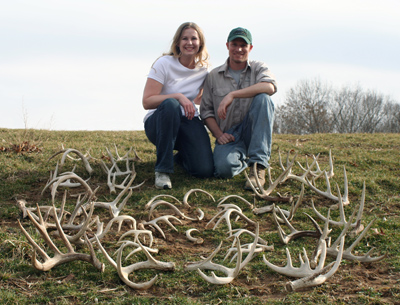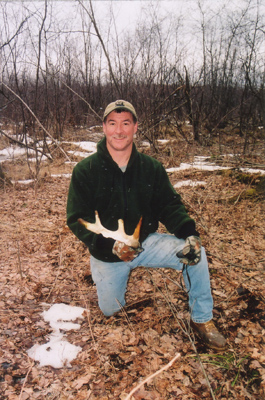A RACK ATTACK...Hunts for whitetail antlers reveal secrets of spring
By Dick Ellis

In their warmer climate, Scott and Amber Moore of
Ottumwa, Iowa had found 28 shed antlers by March 22.
All of these antlers shown were foundin the new springs
of either 2005 or 2006.
By mid-March, Scott and Amber Moore of Ottumwa were two antlers shy of their goal of finding 30 racks in the hill and agriculture country of southern Iowa. With more than 50 racks discovered from whitetail “sheds” in 2005 and 2006, the Moores are in a spring habit they have no intention of breaking.
“I go every day after work for a couple hours,” Scott Moore said. “We’re 30 miles east from where the Lovenstein Buck, the world record non-typical was taken with a bow that scored I believe 316 (Pope and Young archery record book tabulation that measures antler inches, mass and spread to determine score). We found an antler last year that measured 89 inches. That buck could have scored 200. It’s pretty impressive.”
Mike Foss has the fever too. But with more than two feet on the snow dumped on Washburn, Wisconsin from Lake Superior after his first half-rack was discovered during a mild stretch of February weather, Foss said that his search had just resumed.
“When everyone else seems to be fishing spring walleye or steelhead I’m looking for antlers,” said the licensed Wisconsin deer and bear guide. “Spring is the best time to scout for trophy animals, and to start laying your game plan for fall.”
Despite geography and climate making the start to nature’s game of drop and seek widely variable, and in 2012 very early, the passion for antler hunting burns everywhere. Finding a dropped antler, said DNR Wildlife Biologist Alan Crossley, is challenging and fun.
“As graduate students at the University of Maine a bunch of us would go out and look for moose antlers,” he said. “It amazes me that nature will have the moose expend all this energy to grow antlers and then they drop the antlers and do it all over again.”
Dropping and growing again the headgear is the very definition of “antler”. While as examples moose, caribou and elk annually shed and grow antlers, other animals like big horn sheep and bison retain their headgear which are then defined as “horns.” An estimated 150,000 to 200,000 animals in Wisconsin’s statewide post-hunting season herd of whitetail deer being antlered bucks means 300,000 to 400,000 antlers are discarded in the new year and become potential targets of shed hunters.
“Veteran shed hunters don’t wait, they’re right out after the snow melts,” said Crossley. “They know that there are not many out there to find. That serves as anecdotal evidence that within a short time after the antlers fall off the rodents eat them.”
In most geographic regions of Wisconsin, late March (most years) and April is prime time for finding antlers. April, Crossley said, is also when the entire process of antler growth begins again in the whitetail buck.
Changing length of daylight and release of the hormone, prolactin, he said, are thought to trigger antler growth. The antlers appear from the skull with a nerve and blood vessel covering referred to as “velvet” that nurtures the bone and continues to stimulate growth until August or September. Then, he said, the buck’s testosterone increases with the approaching rut, or mating season, the blood supply is shut-off to the antlers and the velvet falls off.
“The buck then has his polished antlers right through the peak of the rut,” he said. “He’ll keep the antlers often right through February at which time the testosterone decreases which triggers the antlers to fall off again. We swing back around to where we are right now and it starts all over again.”
Age, genetics and nutrition, he said, all play roles in antler growth. With his work exclusively in southern Wisconsin, Crossley sees mostly 1.5 and 2.5 year old bucks due to heavy, efficient hunting pressure conducted on more open terrain. Due to nutrition, even a 1.5 year old southern buck may carry an eight point rack which he said is rarely seen in far northern regions of the state. But due to genetics, a 1.5 year old southern buck may also sport a forkhorn rack or spikes.
“In southern Wisconsin we see mild winters and abundant crops with a great nutritional base,” Crossley said. “In the north it’s a tougher life with less agriculture and nutrition.”
Age and genetics are key to big bucks in the north. Antler growth generally improves with age until a buck reaches prime at age five or six. Physical impressiveness including antler growth declines after that. Unbroken northern forests and comparatively light hunting pressure allows bucks to live longer, and grow bigger racks.
Searches for antlers in Milwaukee suburbs New Berlin and Muskego by this reporter and his wife, Lori has not yet paid dividends. Great numbers of deer including very big bucks in the far southeast will keep us persistent in that search.
A mid-March search with Steve Henske near Stevens Point offered a better ending. The transition line from heavy snows in the far north to very little snow on that date driving south on U.S. 39 was between Merrill and Wausau. By Stevens Point, there was virtually no snow covering.
Searching public land, Henske and I would find an enormous, clearly defined wolf track. We saw recent turkey scratchings, found the deer rubs and scrapes of the previous year, and flushed a grouse and one very big gobbler. Finally, where a vast tag alder swamp cornered around the open forest, Henske would find the real treasure; the heavy massed half rack of an eight point buck.
The find and spring scouting also unlocked the secrets of fall. With more knowledge gained came the adjustment of a seasoned hunter.
“I’ve been watching these trails and deer dropping as we moved along the swamp,” Henske said. “I walked over here because of the deer sign and the way the swamp corners here. I looked down and there it was. This is only the second antler I’ve ever found. But I know where I’ll be setting one of my bow stands next fall.”

Steve Henske of Stevens Point found this
heavy massed half rack of an eight point buck
on public land in March. Other secrets of
spring were found with it.
ADVICE FROM THE SHED SEEKERS
In a spring hunt, all racks are trophies. Veteran shed hunters Mike Foss in Washburn and Scott Moore in Ottumwa recommend carrying binoculars even in the big forest to help in the search. Moore offered a few hints for the novice.
“I cover a lot of ground and you train yourself not to look for the whole antler, but maybe just a tine sticking out of the ground,” he said. “The binoculars let you check things out that you see without wasting a lot of time.”
Moore also said that the tall grasses of conservation reserve program (CRP) acreage offer high odds for finding antlers. Ninety percent of his antlers are found on south facing slopes of CRP above food sources. Big bucks, he said, like to sun themselves in that grassy cover with good visibility close to food. Three journeys this spring to one such spot resulted in three new sheds found.
“They love pine trees, cedar trees, scrub brush or some kind of cover out in the CRP,” he said. “They also like to walk in the grass waterways put in off of bean fields to stop erosion. You can find a lot of antlers there.”
Moore was asked if he targets trophy bucks during the fall hunts based on the antlers he finds in spring. He answered, “Well I can dream anyway.”
“I did miss one of these big bucks with my bow last year,” he said. “We found his shed for three straight years. It was neat to see how big he grew in just one year. He put on 23 inches. Even without the excitement of finding one, shed hunting is just good exercise.”
From far northern Wisconsin, Foss said that southern facing ridges are now without snow, but 50 percent of his hunting grounds still have up to 12 inches of snow or more. If the previous fall’s acorn crop was good, he spends much of his time hunting sheds on the oak ridges where the deer had frequented.
“Where I look for antlers up here might change year to year,” he said. “There was not a lot of snow here early in the year and I found one antler. But during a year without a good acorn crop I might be looking for the deer yards (where deer congregate during winters with poor food sources) or young aspen thickets









